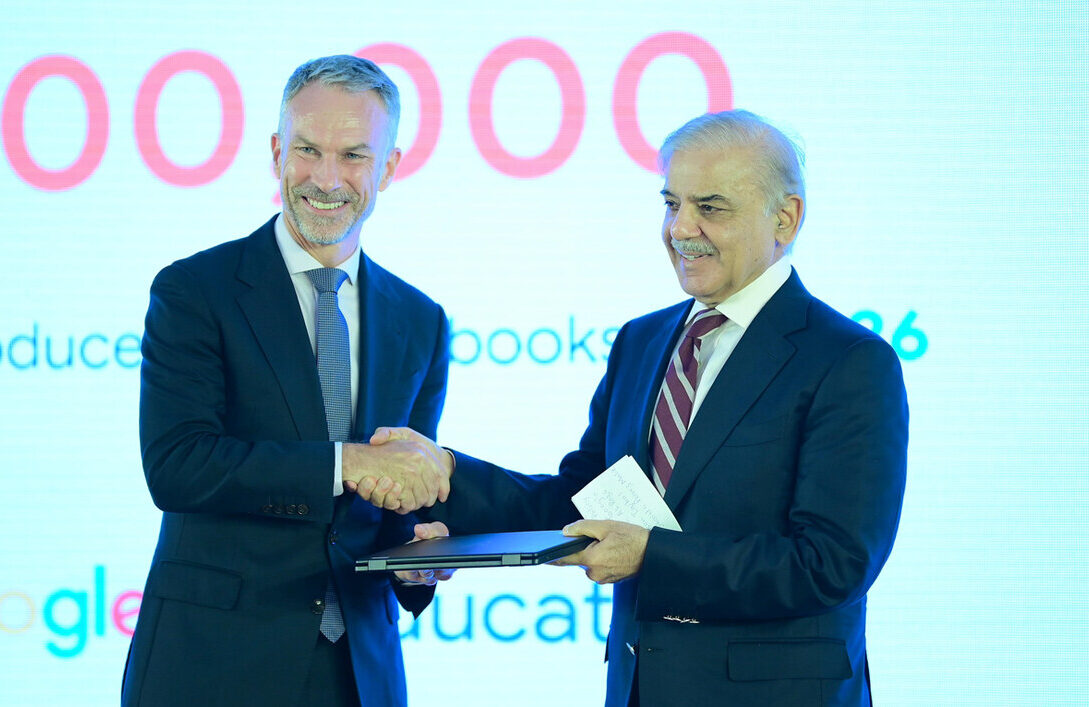In a significant move for South Asia’s tech landscape, Google has announced plans to ramp up its investments in Pakistan, focusing on manufacturing, education, and economic growth. This comes at a pivotal time when Pakistan is pushing hard to elevate its IT sector on the global stage. Prime Minister Shehbaz Sharif recently met with a high-level Google delegation, led by Scott Beaumont, President for the Asia Pacific region, to discuss these initiatives. The meeting highlighted Google’s commitment to producing half a million Chromebooks locally by 2026 and supporting youth training programs.
This announcement isn’t just about hardware; it’s a strategic investment in Pakistan’s youthful population and burgeoning economy. With over 60% of Pakistan’s 240 million people under the age of 30, the country has a massive talent pool waiting to be tapped. Google’s involvement could help Pakistan achieve its ambitious target of $25 billion in IT exports within five years, up from the current $3.2 billion. But what does this mean for businesses, young professionals, and the overall tech ecosystem? Let’s dive deeper.
Google’s Investment Plans: What We Know So Far
During the meeting in Islamabad, the Google delegation outlined several key areas of engagement. Scott Beaumont emphasized that Pakistan’s large youth demographic and expanding economy make it an attractive destination for tech giants like Google.
Chromebook Manufacturing Initiative
One of the standout announcements is Google’s initiative to manufacture 500,000 Chromebooks in Pakistan by 2026. This marks a shift towards local production, which could create jobs, reduce import costs, and foster a domestic tech manufacturing ecosystem.
- Launch Event Highlights: At a special ceremony, the first locally produced Chromebook was presented to PM Sharif, symbolizing the start of this partnership.
- Economic Impact: Local manufacturing could stimulate related industries, such as component supply chains and logistics, potentially adding thousands of jobs in the tech sector.
- Timeline and Goals: Production is set to scale up progressively, with the full target achieved by 2026. This aligns with global trends where companies like Google are diversifying manufacturing away from traditional hubs like China.
This move isn’t isolated; it builds on Google’s previous engagements in emerging markets. For instance, similar initiatives in India have led to increased device accessibility and digital literacy. In Pakistan, Chromebooks—known for their affordability and cloud-based features—could revolutionize education and remote work, especially in rural areas.
Support for Youth Skills Training
Google isn’t stopping at hardware. The company has pledged to support the Pakistani government’s youth skills training programs. This is crucial as Pakistan grapples with high youth unemployment rates, estimated at around 8-10% for those aged 15-24.
- Key Focus Areas: Training will likely cover digital skills, coding, AI, and cloud computing—areas where Google excels through platforms like Google Cloud and its educational tools.
- Government Alignment: PM Sharif has committed funds for youth training, IT infrastructure upgrades, and regulatory improvements to create a conducive environment.
- Potential Outcomes: By equipping young Pakistanis with in-demand skills, this could lead to a surge in freelancing, startups, and IT service exports. Platforms like Upwork and Fiverr already see heavy Pakistani participation, and enhanced training could amplify this.
Scott Beaumont noted that maximizing technology’s economic benefits requires leveraging Pakistan’s demographics. This echoes broader global strategies where tech companies invest in education to build future user bases and talent pipelines.
Pakistan’s IT Export Ambitions: The $25 Billion Target
PM Sharif has set an aggressive goal: reaching $25 billion in IT exports by 2029. This represents a massive leap from the fiscal year 2023-2024 figures, where exports hit $3.2 billion—a 24% increase from the previous year’s $2.59 billion.
Current State of Pakistan’s IT Sector
Pakistan’s IT industry is nascent but promising. Key drivers include:
- Low-Cost Talent Pool: Competitive wages make Pakistan attractive for outsourcing software development, app creation, and data services.
- Growing Freelance Economy: Over 100,000 Pakistanis are active on global freelance platforms, contributing significantly to foreign exchange.
- Government Incentives: Recent policies include tax breaks for IT firms, special economic zones, and initiatives like the Digital Pakistan Vision.
However, the sector’s growth has been impressive. From call centers in the early 2000s to advanced AI and blockchain startups today, Pakistan is evolving. Companies like Systems Limited and Netsol have gained international recognition, exporting services to the US, Europe, and the Middle East.
Pathways to Achieving the Target
PM Sharif challenged stakeholders to provide a “pathway” to the $25 billion mark. Based on industry insights, here are potential strategies:
- Infrastructure Investment: Upgrading broadband, data centers, and power reliability to support remote work and cloud services.
- Skill Development Programs: Partnerships like Google’s could train 1-2 million youth annually in high-demand areas.
- Export Promotion: Marketing Pakistani IT firms at global events and easing visa processes for business travel.
- Innovation Hubs: Establishing tech parks in cities like Lahore, Karachi, and Islamabad to attract foreign investment.
If successful, this could generate billions in foreign exchange, crucial for a country facing balance-of-payment issues. For context, IT exports already outpace traditional sectors like textiles in growth rate, signaling a shift towards a knowledge-based economy.
Challenges Facing Pakistan’s Tech Push
While the announcements are optimistic, Pakistan’s tech sector isn’t without hurdles. Recent internet slowdowns have highlighted vulnerabilities that could derail progress.
Internet Disruptions and Their Impact
Over the past few weeks, internet speeds in Pakistan have dropped by 30-40%, affecting millions and drawing complaints from businesses and users alike.
- Attributed Causes: The Pakistan Telecommunication Authority (PTA) blames damaged underwater cables, while IT Minister Shaza Khawaja points to increased VPN usage.
- Suspected Reasons: Digital rights groups suspect it’s linked to trials of a national firewall aimed at curbing “anti-state propaganda.” The government denies censorship intentions.
- Economic Toll: The Pakistan Software Houses Association (P@SHA) estimates losses up to $300 million from disruptions, impacting freelancers and exporters reliant on stable connections.
These issues underscore the need for robust infrastructure. Without reliable internet, investments like Google’s could falter, as remote collaboration and cloud services depend on high-speed access.
Broader Obstacles
Other challenges include:
- Regulatory Hurdles: Complex bureaucracy can deter foreign investors.
- Skill Gaps: While youth are abundant, advanced training in emerging tech like AI and cybersecurity is limited.
- Geopolitical Factors: Regional instability might affect investor confidence.
Addressing these will require collaborative efforts between the government, private sector, and partners like Google.
The Broader Implications for Global Tech and Emerging Markets
Google’s investment in Pakistan fits into a larger pattern of tech giants eyeing emerging markets for growth. With saturated markets in the West, companies are turning to Asia and Africa for expansion.
- Benefits for Google: Access to a young, tech-savvy population could boost adoption of Google services, from Search to Workspace.
- Lessons from Similar Initiatives: In Vietnam and Indonesia, Google’s manufacturing and training programs have led to economic upliftment and increased digital inclusion.
- Global Tech Trends: This aligns with the push for supply chain diversification post-COVID, reducing reliance on single countries.
For Pakistan, this could position it as a regional tech hub, competing with neighbors like India and Bangladesh. If the $25 billion target is met, it could inspire other developing nations to prioritize IT as an economic driver.
To learn more about global tech investments, check out this article on Google’s initiatives in India or our internal post on emerging tech markets in Asia.
Conclusion: A Bright Future Ahead?
Google’s increased investments, Chromebook manufacturing, and youth training support mark a turning point for Pakistan’s tech sector. As the country strives for $25 billion in IT exports, partnerships like this provide the momentum needed. However, overcoming challenges like internet reliability will be key to success.














